- Home
- Deborah Blum
Love at Goon Park: Harry Harlow and the Science of Affection Page 16
Love at Goon Park: Harry Harlow and the Science of Affection Read online
Page 16
Harry was called, on occasion, to be the mediator between the students, the staff, and Peggy. Sometimes the disagreements even spilled out of her office, where she kept a little desk lamp that allowed her to work in a small, warm pool of light. Peggy always hated the cold brightness of fluorescent light. When she had to share her office with students, it turned into a battle with those who wanted overhead lights. California psychologist Bill Mason, a postdoctoral researcher in the lab, remembers Harry trying to referee one particularly angry dispute and walking away with some relief. “I think I came through that pretty well,” he told Bill, ignoring the mutterings following him down the hall.
He and Peggy had two children. Pamela Ann Harlow was born on September 20, 1950. Peggy was unreserved in her delight in her daughter’s arrival. “Years of training, both experimental and clinical, have not deprived Peggy of the privilege of thinking that Pamela is ‘real cute.’ This is no doubt correct, though she looks to me like a baby girl,” Harry wrote to Terman. On the same letter, Peggy scribbled a far more sentimental note: “As Harry implies, I am completely won over by our month-old daughter. She’s a lively baby and has learned some things a little faster than her parents would like, but we wouldn’t want too ‘good’ a baby.” Peggy was equally excited about their second child, Jonathan, born three years later.
In that brief baby note, you can see a warmer, sweeter side to Peggy Harlow than generally showed in the lab. There she worked hard to maintain professional dignity. At home, she could put that away. She could laugh and play with her children. By most accounts, Peggy Kuenne Harlow was selective in her relationships. She loved a very few people and she saved her energy for the people who mattered to her most. She wrote regularly to her sister, Dorothy. But it was Harry who took over most of the correspondence with Peggy’s mother. The Harlow files at Wisconsin still contain a thick packet of letters to the elder Margaret Kuenne and they all begin, “Dear Mother.” And they all close, “love, Harry.” Even now, Peggy’s brother, Robert, recalls how kind Harry was to their mother. And what a wonderful mother his sister Peggy was to her children. “She really loved those children,” he says.
Peggy wasn’t a natural homemaker. It wasn’t, after all, her first interest. She didn’t know how to cook when she got married. But she clipped recipes and studied them and learned. She planned healthy meals (although when the children were sick, she brought them icecream sodas to eat in bed). She didn’t try to keep the house immaculate. Visiting students recall dusty furniture and piles of papers everywhere. The papers might be expected because she and Harry both brought work home constantly. There were usually school projects spread out in one corner of the home or the other. “There was never enough time to fight that uphill battle for tidiness,” Pamela says. Today you would think of the Harlow house as the typically cluttered home of working parents with children, a family where you choose your domestic priorities. The house might not be polished to 1950s homemaker standards, but Peggy always made time for her children.
When he could spare the time, Harry appreciated the challenges of parenting. He just thought they were a lot funnier than Peggy did. He loved to tell friends about his efforts to teach Jonathan how to put on a seat belt in the car. Child psychologist Dorothy Eichorn, of the University of California at Berkeley, was one of Harry’s closest professional friends. She still remembers him chortling over his parenting skills. “He had this story he would tell on himself about when seat belts first were installed in cars. And he was trying to train Jonathan to use them and they’d gotten in the car and he said to Jonathan, ‘Now, what’s the first thing you do when you get in the car?’ and Jonathan said, ‘Shut the door.’ And he thought that was just wonderful.” Eichorn thought it was Harry’s ability to laugh at himself that made it easy for him to charm a child. “He had a wonderful sense of humor and he knew how to capture children’s interest. He taught my son to pitch pennies—not that I was so happy about that. But he enjoyed himself and I think he enjoyed children.”
Harry and Peggy purchased a comfortable, 1920s house near the zoo and he would walk his daughter down to the park on clear nights to star-spot. Neither of them were experts on the constellations but they always picked out the Big Dipper. Harry taught Pamela how to whistle and to sharpen pencils with a knife. She no longer whistles, but she still makes pencil points with a knife. Some Sunday mornings, he would prepare oranges for the children in grapefruit style, cut into neat spoonable sections. He taught his children to play bridge, Jonathan remembers, and sometimes played tennis with them. He attended school picnics and plays during lulls in the research agenda. “But that was about it,” Jonathan Harlow said. “He really didn’t do much for fun. My father really spent morning, noon and night at the lab. He would walk home for dinner and then go back to the lab and work. My mother was a child psychologist and I think she really wanted children and my father had had children before with Clara and I don’t think he was that interested in us.”
Of course, this was the 1950s. How many fathers were that engaged with their families and housework then? It was mothers who made the costumes and coddled the sick children and spent their extra hours at home. But there is a valid point in Jonathan’s comment. During his first marriage, and then when he was on his own, Harry had discovered that there are other, less traditional ways of making a family. And it was his other family—the intellectual one—that often occupied him more, and sometimes seemed nearer and dearer to his heart.
He built his other family at the laboratory. It contained an extended network of graduate students, and post-docs, and dedicated staff, and he loved being there, in that family, as much as any place in the world. Personal relationships could fail, as he had learned, and disappear. But down at the primate laboratory, there was always a person willing to listen, and work to be done, and a sanctuary from the math-minded discussions of his colleagues. There was always another interesting idea to huddle over or an animal breaking one rule of psychology or another.
His students’ recollections of him, from this time, balance between affection and amusement. He was thinner now, slighter, more burned out in appearance. A seemingly fragile man, constantly hurrying through the halls of the primate lab, almost tilted forward in his hurry. “Harry Harlow did not just walk,” former graduate student John Gluck wrote. “He walked bent precariously at the waist in a manner which required that his feet shuffle rapidly forward to prevent him from tipping over.”
When Bob Zimmermann came to the Wisconsin lab, he was sent directly into a conference room to meet his new professor: “There were four or five people. I’d never seen them before. And one was a guy with a crew cut. Another was a distinguished guy in a suit. And then there was this little guy with glasses, wearing a sloppy shirt and he had on these, I forget what you used to call them, but they were denim elastic-top kind of pants. This last guy came walking out with a cigarette dripping, just hanging out of his mouth and his hand comes out and he says, ‘I’m Harry Harlow.’”
Harry had always had the potential to be an eccentric. He’d been an oddball kind of child, dreaming of trains to the moon instead of settling into the solid decent Iowa culture. A quirky kind of graduate student, with his poetry-sprinkled notes and wry approach to doing what he was told. Everything that had happened to him at Wisconsin—from his zoo-based research to his fallen first marriage—had conspired to nourish the offbeat parts of his nature. He was in his late forties now and he no longer cared about being someone else’s image of a rising psychology star. He might have hidden his poems while at Stanford but now he left them on his students’ desks at night.
Harry had never cared much about status symbols; clothes and cars and houses didn’t impress him. He liked to be paid well. He just wasn’t interested in wearing his money. Peggy, who liked to hoard for the future, encouraged that indifference. Helen LeRoy, who was both assistant and friend, recalls driving with Harry to pick up a visiting Soviet scientist at an elegant lakefront hotel. They swept up the circ
ular drive in the Harlows’ tan-and-cream Chevrolet. It was their one car, it was almost ten years old, it was covered with dings and rust spots. LeRoy remembers thinking, “At least he won’t think we’re rich American capitalists.”
Harry was not at all self-conscious about the car. Or the clothes. He was so consumed by the ideas, bubbling inside, that he rarely remembered exterior appearance. Or even what he was wearing at a given moment. He left a trail of hats, coats, and scarves across the country every time he traveled for business; his files are full of query letters to friends and hotels, wondering whether they had found his garments. LeRoy sometimes worried for him. It bothered her that Harry looked increasingly as if he had dressed himself at a thrift shop. This came home to her on a day of errand-running. Harry liked to visit his bank, First Wisconsin, in the morning when it routinely put out coffee and donuts for customers. One day, they were standing together by the coffee table, talking, when a teller called out, “Dr. Harlow? Could I ask you a question?”
As Harry walked over, a woman standing next to Helen whispered, “Is that Harry Harlow?” She nodded.
The woman gestured toward Harry’s thready overcoat, saying, “I thought he was someone who came off the street for coffee.”
Still, LeRoy laughs remembering. Harry thought it was funny. He could never resist a joke on himself. He didn’t mind being odd as long as he made an impression. “He’d say, if you want them to remember you, make them laugh,” says a former graduate student, Lorna Smith Benjamin. That same casual indifference toward impressing others certainly characterized his old laboratory with its shaggy yard and chipped walls. He was proud of it, fond of it, he might have kept that laboratory indefinitely if the University of Wisconsin hadn’t almost forced him into something better. As far as Harry could tell, the change wasn’t a vote of confidence in his research; it was a vote against the appearance of his laboratory. The nearby engineering department had complained about the eyesore in its backyard. The university’s president had toured the lab and informed Harry that he looked forward to tearing the dump down. “I was shocked,” Harry wrote. “This was my bride and all brides are beautiful.” Still, he was happy to put in a request for a larger building and remodeling money and, in the end, the university did give him a new building—this time an abandoned cheese factory—and refurbishing money as well. His second laboratory lacked a yard but it was at least three times the size of the first.
At his new building, finished in the early 1950s, Harry put together the kind of creative lab family that suited him. He didn’t care whether staff and students came from a status school or had a perfect academic track record. He created a laboratory filled with people who were interested in the work and people who interested him. He accumulated students recommended by friends, students he liked, and students he thought were just plain smart.
Gerald McClearn, now an acclaimed behavioral geneticist at Penn State, remembers that he went to Wisconsin because Harry happened to give a speech at his small undergraduate college. McClearn’s major professor at Allegheny College marched him up to Harry afterwards and said, “Harry Harlow, you don’t know me, but if you don’t take this boy to be a grad student, you’re missing a big bet.” “[Harry] looked amused, asked me a few questions, and after five minutes, he said, ‘Okay, you’ll do. Call and tell them you’re in.’” McClearn laughs: “I hadn’t even applied.”
Once there, “You were essentially encouraged to do whatever you wanted to do,” says John Gluck, now a psychology professor at the University of New Mexico. “He didn’t give you specific work to do. The lab had tremendous resources and you were expected to make use of them.” If he thought you were any good, he gave you enormous room to experiment—so much room that he sometimes lost track of what students working in the lab were up to. Another student remembers that after he had completed his Ph.D. dissertation, he handed the thickly stacked papers to Harry. The professor halted, studied the document at hand and said, “Okay, now I’ll find out what you’ve been doing all this time.”
Another of Harry’s research assistants, Marvin Levine, had come from B. F. Skinner’s lab at Harvard. Skinner was working only with pigeons when Levine was there. The great man rarely showed up in the lab; instead, he gave the lab managers instructions to be carried out in his absence. Every graduate student knew those instructions had to be carried out with military precision. Skinner liked his lab formal in manner and orderly in operation. He had even written guidelines for how to take pigeons out of a cage and how to return them. So that Levine also remembers the almost cold-water shock of coming to Harry’s lab, where he “would give you as much responsibility as you could take.”
The first impression could be deceptively chaotic. Over the years, Harry had clinical psychology students, hard-line experimentalists, and students interested in learning, fascinated by emotions, wondering about relationships between animals. He allowed students who had no idea what they were interested in at all. The permanent staff of the primate laboratory was composed of people holding degrees in psychology, economics, literature, music, or what John Gluck liked to call “diplomas in curiosity.”
Harry supported students through the fine ideas and the fanciful ones and the failed ones. One of his most inventive graduate students was a New York–raised psychologist named Leonard Rosenblum. While at the Harlow lab, Rosenblum invented a mechanical head to scare monkeys. He was interested in exploring animals’ fear responses. “I decided to make a threat face. In order to do it, I sculpted a head out of balsa wood with a hinged jaw and hidden teeth that would be exposed when the jaw opened. Another thing, the ears would flap. So, when I pressed a switch, the jaw opened, the ears flapped back.”
Rosenblum put this theoretically terrifying face onto wheels. He wanted it to roll on a little track, something like a toy train. The track ran into a playroom where he was already working with a group of monkeys. But when he rolled out the head, the monkeys—long-used to new experiments by enthusiastic students—yawned. “Harry’s experienced monkeys really didn’t pay much attention the first couple times,” Rosenblum continues. He decided he needed more drama. “So I attached a buzzer to catch their attention. I attached it but I didn’t insulate the lead wire. I decided to show Dr. Harlow to get his approval. That wasn’t easy to get from Harry. Not overtly, not to your face. I cajoled him into seeing this.”
They stood together in the playroom as the head rolled out on the track. As it moved forward, the exposed leads struck the track. Sparks shot up. The circuits blew. The room went dark. Rosenblum braced himself for an explosion from his professor. Quietly, the door leading out of the room opened. Harry stood silhouetted against the light. “Very impressive, Rosenblum,” he said.
“That was it. He left, he never mentioned it again and I was never in any way punished for it.” Even now, Rosenblum can’t help grinning at the memory. This is not to say that Harry would allow a faulty idea to continue indefinitely, and Rosenblum remembers that as well. In his first year at Harry’s lab, he had decided to test the social activity of monkeys in a maze. Rosenblum wanted it to be a memorable maze. And it was. It filled an entire room; it crowded against the walls. The monkeys drifted around in the maze, idly curious. But there wasn’t any notable social difference to measure. “I was months in it and it wasn’t working but I was doggedly at it. Harry didn’t say a thing.
“And then one day he came up and said, ‘Rosenblum, take a sledgehammer to that thing and get rid of it.’”
“I said, ‘Get rid of it?’ Rosenblum’s voice rises as he recalls his shock.
“He said, ‘Get rid of it. You’ve got to know when to quit.’”
And again, that was it. “He never held it against me and he was right—you do have to know when to quit. If you cling to errors, you never learn the right way. It was a very difficult lesson. I was embarrassed and ashamed. But he didn’t see it that way. It was that it was over. It was a hard lesson and an important one and I’ve held onto it.” Rosenblum went
on to a heralded career at the State University of New York, directing a behavioral primate laboratory in Brooklyn, and exploring the social development of children.
“Harry never punished you for trying,” Rosenblum continues. “He was at his best, most sympathetic, when you were down. He never turned his back on people who screwed up.” Harry would even rescue people. Another graduate student, Kenneth Schiltz, had been unable to survive the statistics gauntlet of the psychology department. When Schiltz dropped out, Harry almost immediately gave him a lab job. As many students remember, including Rosenblum, Kenny Schiltz took over the nurturing and the handholding duties at the lab. It might have been difficult to wring overt praise from Harry, but Ken Schiltz loved to tell people that they were doing well. “This lovely man, a defunct ex-grad student of Harry’s, stayed with him for years, acting as a drinking companion, a sort of lab manager, researcher, and older brother to the grad students,” Rosenblum says.
And brother is a good word for the relationship because, for Harry, the lab was family. Because it was often his first family, he came to expect his students to see it that way, too. If grad students had children, they often brought them to the lab. Many have memories of babies bundled into blankets and sleeping in offices or the break room. “The first year I was there, I said I can’t be at a meeting, I’m going home for Thanksgiving. And Harry just looked at me and said, ‘You’re going to have to give all that up,’” recalls Lorna Smith Benjamin, now at the University of Utah.

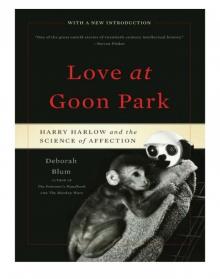 Love at Goon Park: Harry Harlow and the Science of Affection
Love at Goon Park: Harry Harlow and the Science of Affection The Poison Squad
The Poison Squad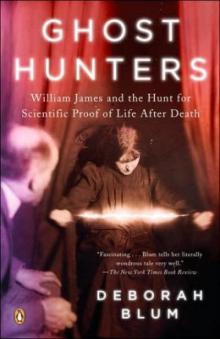 Ghost Hunters: The Victorians and the Hunt for Proof of Life After Death
Ghost Hunters: The Victorians and the Hunt for Proof of Life After Death The Poisoner's Handbook
The Poisoner's Handbook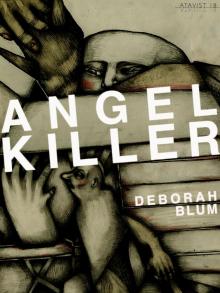 Angel Killer
Angel Killer The Best American Science and Nature Writing 2014
The Best American Science and Nature Writing 2014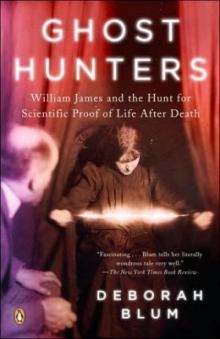 The Ghost Hunters
The Ghost Hunters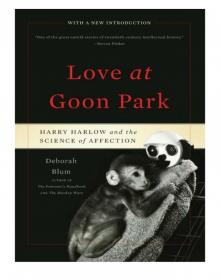 Love at Goon Park
Love at Goon Park